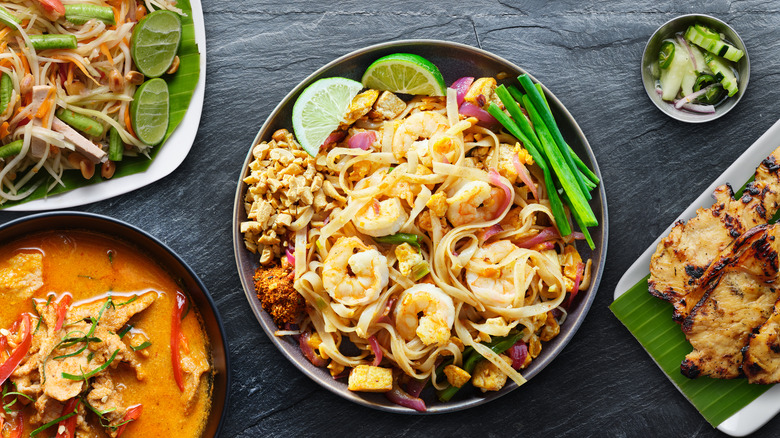14 Essential Ingredients For Cooking Thai Food At Home
Everything you need to master Thai cooking at home
As the country (finally) collectively thaws after a particularly nasty winter, Thai restaurants are heating up from coast to coast. Andy Ricker's Pok Pok empire is expanding to Los Angeles, with Pok Pok Phat Thai already open and Pok Pok L.A. on its way. In Houston, chef PJ Stoops is set to unleash Foreign Correspondents this spring, and international chain Mango Tree recently opened its first American outpost in Washington, D.C.
In San Francisco, chef James Syhabout, who's from Northeastern Thailand, just opened a second location of his well-received Thai street food restaurant, Hawker Fare. But you don't need to eat out to get a taste of Thailand. After a recent cultural and culinary tour of his home country to hone in on the flavors he's serving, Syhabout helped put together a guide to mapping out everything you need to cook great Thai food at home.
Galangal
Galangal, like ginger, is a rhizome, and the two are closely related. Galangal, however, "imparts a totally different flavor," Syhabout says. "Ginger is definitely not a substitute." Be sure to find the real deal, which can mean buying frozen galangal if necessary.
Makrut Lime
Makrut limes are used for their leaves and skins. The fruit doesn't yield much juice, but the essential oils in the peel provide great aromatics for curries and curry pastes.
Fish Sauce
Fish sauce is used as salt in Thai cuisine. "It's the backbone of Thai cooking," Syhabout says, noting that it also imparts umami. But not all fish sauces are created equal. "People don't realize, but there's a huge variation across brands," Syhabout says. His choice is Tiparos, but he suggests conducting a personal tasting as you might with an array of olive oils.
Oyster Sauce
Oyster sauce is used in stir-fries and marinades. "A little goes a long way," Syhabout says. Try to find actual oyster sauce, such as Maekrua, though Chinese-style "oyster-flavored sauce" will work in a pinch.
Thai Bird (Bird's Eye) Chile
The Thai bird or bird's eye chile is ubiquitous—and very hot. "It will punch you in the nose," Syhabout warns. "It's a sharp spice." They're best to use fresh, however fresno or serrano chiles are fine substitutes.
Thai Basil and Holy Basil
Thai basil and holy, or hot, basil are both different from the "sweet" Genovese basil more common in the United States. Holy basil is used in stir-fries to impart herbal and anise notes, and Thai basil, with its beautiful purple stems and buds, is commonly used in soups, where it lends a sharper, bolder flavor.
Palm Sugar
"Palm sugar is the best," Syhabout says. It offers a caramelized sweetness similar to light brown sugar, with a woodsy, earthy undertone. You'll likely find it in small, hardened "cakes" or blocks, which can be shaved, melted and incorporated into a dish.
RELATED Yam Samun Phrai is Thai for "Delicious" "
Coconut Milk
There's no Thai curry and no tom kha soup without coconut milk, meaning you should have plenty on hand and ready to go at all times. Syhabout suggests AROY-D coconut milk—cartoned, not canned.
Tamarind
The acidic kick from tamarind isn't as sharp as lime. "It's more round and balanced," Syhabout says. It's used in various soups, sauces and marinades, and Syhabout also fondly remembers his mother making homemade tamarind jam to spread onto toast.
Sticky Rice
Sticky rice is an indispensable staple in most Thai meals, sopping up sauce and flavor and offering an easy mode of delivery.
Bamboo Cone Sticky Rice Steamer
To make great sticky rice at home, "you have to have the right equipment for the right job," Syhabout says. As opposed to a regular steamer set, he suggests specially made woven bamboo cones, placed over a corresponding pot to steam the rice while ensuring the water never makes direct contact. For the best results, soak the rice in water for 24 hours and strain it prior to steaming.
Wok and Metal Spatula
There's no such thing as the perfect wok. Instead, choose the shape or size that allows you to extract as much heat as possible. Syhabout warns though that you really need a gas stove to make woks work. . "If you have an electric stove, you're pretty much screwed," he says.
Mortar and Pestle
Mortar and pestles are must-haves, used for everything from hand-pounding curry paste and sauces to creating som tum (green papaya salad).
Thailand: The Cookbook, by Jean-Pierre Gabriel
Jean-Pierre Gabriel's beautifully photographed cookbook has been hailed as one of the most definitive collections of authentic Thai recipes available. The book boasts more than 500 recipes, sourced from each corner of the country.
